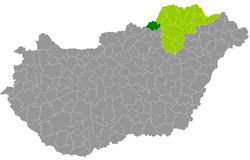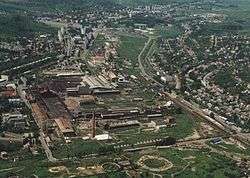Ózd District
Ózd (Hungarian: Ózdi járás) is a district in western part of Borsod-Abaúj-Zemplén County. Ózd is also the name of the town where the district seat is found. The district is located in the Northern Hungary Statistical Region.
Ózd District Ózdi járás | |
|---|---|
 Coat of arms | |
 Ózd District within Hungary and Borsod-Abaúj-Zemplén County. | |
| Country | |
| County | Borsod-Abaúj-Zemplén |
| District seat | Ózd |
| Area | |
| • Total | 385.57 km2 (148.87 sq mi) |
| Area rank | 9th in Borsod-Abaúj-Zemplén |
| Population (2011 census) | |
| • Total | 54,285 |
| • Rank | 3rd in Borsod-Abaúj-Zemplén |
| • Density | 141/km2 (370/sq mi) |
Geography
Ózd District borders with the Slovakian region of Banská Bystrica to the northwest, Edelény District to the northeast, Kazincbarcika District to the east, Bélapátfalva District and Pétervására District (Heves County) to the south, Salgótarján District (Nógrád County) to the west. The number of the inhabited places in Ózd District is 17.
Municipalities
The district has 2 towns, 1 large village and 14 villages. (ordered by population, as of 1 January 2012)[1]
- Arló (3,686)
- Borsodbóta (857)
- Borsodnádasd (3,007)
- Borsodszentgyörgy (1,135)
- Bükkmogyorósd (119)
- Csernely (806)
- Csokvaomány (843)
- Domaháza (816)
- Farkaslyuk (1,759)
- Hangony (1,480)
- Járdánháza (1,792)
- Kissikátor (312)
- Lénárddaróc (289)
- Nekézseny (735)
- Ózd (33,750) – district seat
- Sáta (1,037)
- Uppony (309)
The bolded municipalities are cities, italics municipality is large village.
Demographics
Religion in Ózd District (2011 census)
In 2011, it had a population of 54,285 and the population density was 141/km².
| Year | County population[2] | Change |
|---|---|---|
| 2011 | 54,285 | n/a |
Ethnicity
Besides the Hungarian majority, the main minorities are the Roma (approx. 7,000) and German (200).
Total population (2011 census): 54,285
Ethnic groups (2011 census):[3] Identified themselves: 54,404 persons:
- Hungarians: 47,043 (86.47%)
- Gypsies: 6,808 (12.51%)
- Others and indefinable: 553 (1.02%)
Approx. 150 persons in Ózd District did declare more than one ethnic group at the 2011 census.
Religion
Religious adherence in the county according to 2011 census:[4]
- Catholic – 25,396 (Roman Catholic – 24,485; Greek Catholic – 909);
- Reformed – 3,548;
- Evangelical – 305;
- other religions – 1,435;
- Non-religious – 9,949;
- Atheism – 459;
- Undeclared – 13,193.
Gallery
 Ózd, the district seat
Ózd, the district seat_2.jpg) Blower Engine Room in Ózd Metallurgical Works
Blower Engine Room in Ózd Metallurgical Works- View of Farkaslyuk
- Church of the Nativity of the Virgin Mary in Járdánháza
See also
- List of cities and towns of Hungary
- Ózd Subregion (until 2013)
References
- A KSH 2012. évi helységnévkönyve
- népesség.com, "Ózdi járás népessége"
- 4.1.6.1 A népesség nemzetiség szerint, 2011, (in Hungarian)
- 4.1.7.1 A népesség vallás, felekezet szerint, 2011, (in Hungarian)